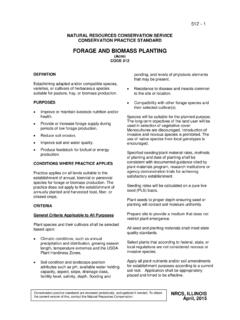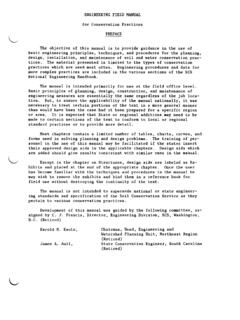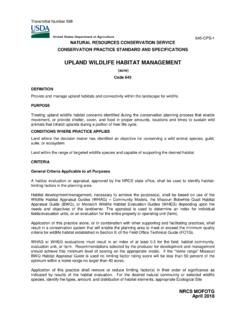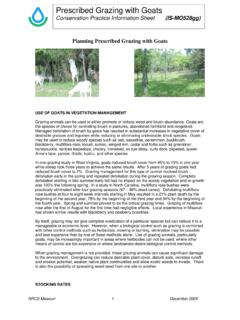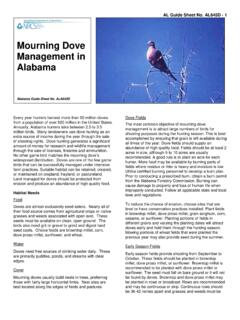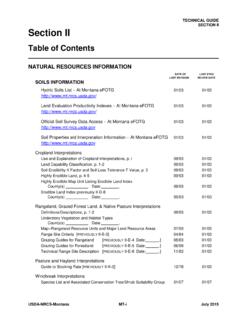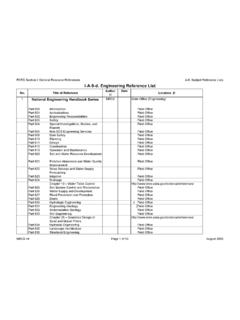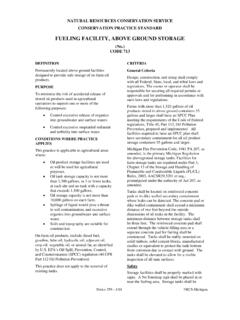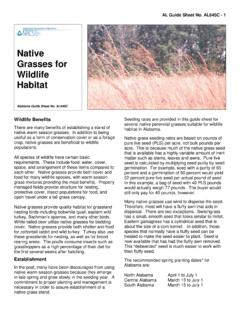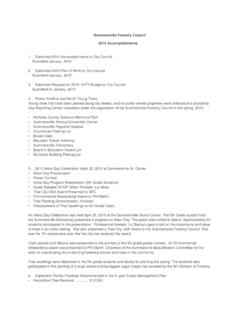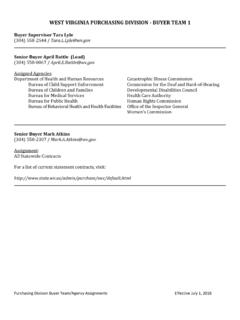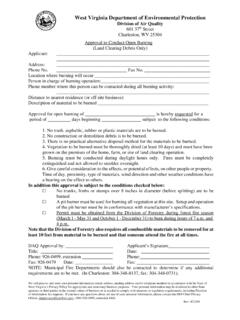Transcription of NATURAL RESOURCES CONSERVATION SERVICE …
1 612 Design Guide January 2015 Page 1 of 39 NATURAL RESOURCES CONSERVATION SERVICE TREE/SHRUB ESTABLISHMENT CODE 612 Design Guide Species Selection WV NRCS Personnel should work closely with WV division of forestry personnel, the NRCS staff forester, and/or biologist when utilizing this practice. Composition of species will be adapted to site conditions and suitable for the planned purpose(s) and will accomplish the client s objectives. Plant Guide and Plant Information Sheets for individual species found in the USDA Plants Database will be utilized to supplement the material in this standard. For selection of species to be encouraged through NATURAL regeneration and a listing of those that may be planted, refer to one ore more of the following: A. Tree and Shrub Lists for WV found in Section IV Tools of the WV eFOTG.
2 B. Veg Spec See NRCS homepage - Field Tools resource Information C. Technical Guide Reference (Plant Materials) Plant Selection Guide, Joe Ruffner D. Technical Guide Reference (Plant Materials) CONSERVATION Plants for the Northeast, USDA-SCS E. Technical Guide Reference (Biology) Shrubs and Trees for Northeastern Wildlife, USFS General technical Report, NE-9, 1974 F. Technical Guide Reference ( forestry ) CONSERVATION Tree and Shrubs Pocket ID Guide, USDA SCS, 1993 G. Technical Guide Reference ( forestry ) Chesapeake Bay Riparian Handbook A Guide for Establishing and Maintaining Riparian Forest Buffers, USFS, May 1997, Section VII Site Evaluation, Planning and Establishment H. CONSERVATION Tree and Shrub Groups found in Section IV Tools of the WVeFOTG. I. Soils Information Web Soil Survey ( ) Soil Data Mart ( ) Printed Soil Survey ( ) Section II Soils Information of the WVeFOTG J.
3 WV Job Sheet 391 Trees and Shrubs Recommended for Riparian Forest Buffers Section IV eFOTG K. WV Pollinator Handbook L. Appalachian Regional Reforestation Initiative (ARRI) Forest Reclamation Advisory No. 5 MINE RECLAMATION PRACTICES TO ENHANCE FOREST DEVELOPMENT THROUGH NATURAL SUCCESSION (July 2007) and No. 7 PLANTING HARDWOOD TREE SEEDLINGS ON RECLAIMED MINE LAND IN APPALACHIA (February 2010) Note: Other species not listed in the above reference materials may also be suitable. Consult WV division of forestry personnel, NRCS staff forester and/or biologist concerning the suitability of other species. Wet Areas/Soils Use adapted species. Another consideration would be to plant in prepared ridges. The planned plant species must be tolerant of any nutrient, pesticide, mine drainage, soil condition or other chemical loading, where loading cannot be corrected.
4 Comply with applicable federal, state, and local laws and regulations during the installation, operation and maintenance of this practice. 612 Design Guide January 2015 Page 2 of 39 Care and Planting of Seedlings/Cuttings Site Preparation A precondition for tree/shrub establishment is appropriately prepared sites. Site preparation is needed if competition from grass, weeds, and/or woody materials will interfere with plant establishment and growth. Refer to WV CONSERVATION practice standards Tree/Shrub Site Preparation, 490 and/or Brush Management, 314, as applicable. Care, Handling, Size Requirements for Woody Planting Stock The following should be done when seedlings are received to increase survival rates: To optimize survival, plant seedlings immediately upon their arrival from the nursery. If this is not possible, the bundles can be stored for two days in a cool (34 -38o F), dark place.
5 Do not unpack the bundles! Water the bundles periodically to ensure the roots are well moistened. It is critical that the roots never be allowed to dry out; exposure to the air for even a few minutes can kill your seedlings. If controlled storage is not available and seedlings cannot be planted within two days of receipt, dig a trench about one foot deep and bury the seedling roots in soil. This is called heeling-in . See Figure 1. Pack the soil firmly, water thoroughly, and make certain all roots are covered. Evergreens require extreme care. When heeling in evergreens, split bundles and spread out the seedlings in the trench to make sure the root system of each seedling is protected by soil. Figure 1 Healed-In Seedlings (Source: WV Department of Agriculture Form FM-18) Live cuttings that will not be immediately planted shall be promptly placed in controlled storage conditions (34-38o F) and protected until planting time.
6 Plant Inspection Check planting stock at the time of planting to see if it is free of disease, insects, and mechanical injury and have a well-developed root system. All conifers must have dormant buds. Seedlings shall not be less than inch in caliper at 1 inch above the root collar. For cuttings, avoid using material less than in diameter. Tops of dormant-season collected cuttings may be dipped into latex paint, paraffin or sealing wax to prevent desiccation and mark the up-end. Rooted planting stock must not exceed a 2:1 shoot-to-root ratio and have a minimum of a 1:1 root shoot ratio. General size guidelines are as follows: Hardwoods - seedlings should have a minimum height of 6-12 inches and a minimum root length of 10 inches. Conifers - seedlings should have a minimum height of 6-12 inches and a minimum root length of 8 inches 612 Design Guide January 2015 Page 3 of 39 Planting Time Trees/shrubs can be planted in the fall from the time growth stops until the soil is frozen; or in the spring after the soil has thawed until bud break which usually occurs by April 15th in most places in West Virginia.
7 Avoid fall planting in clay soils due to frost heaving. Planting Methods Planting methods used should be designed to minimize soil erosion. Timing and use of planting equipment will be appropriate for the site and soil conditions. Seedlings may be planted with any of the following: mattock, planting dibble, hoedad, planting bar, tile spade, post hole digger, tractor/auger, or tree planting machine. The method of planting will depend on the terrain and the type of seedlings being planted. The technique used should ensure the proper depth and placement of planting stock roots. Roots of bareroot stock shall be kept moist during planting operations. Any directions received with the seedlings regarding care of the seedlings while planting shall be followed. If no directions accompany the seedlings, roots of bareroot stock shall be kept moist during planting operations by placing the seedlings in a water-soil (mud) slurry, peat moss, super-absorbent ( , polyacrylamide) slurry or other equivalent material.
8 Rooting medium kept moist at all times by periodic watering. Pre-treat stored cuttings by soaking just before planting. Stock shall not be planted when the soil is frozen or dry. Rooted stock will be planted in a vertical position with the root collars approximately -inch below the soil surface. Insert cuttings to the depth required to reach adequate soil moisture. The planting trench or hole must be deep and wide enough to permit roots to spread out and down without J-rooting or L-rooting. After planting of rooted stock or cuttings, pack soil around each plant firmly to eliminate air pockets. See Figure 2. Dibble Planting Technique (1) Insert the dibble straight down into the soil to the full depth of the blade and pull back on the handle to open the planting hole. (DO NOT rock the dibble back and forth as this causes soil in the planting hole to be compacted, inhibiting root growth.)
9 (2) Remove the dibble and push the seedling roots deep into the planting hole. Pull the seedling back up to the correct planting depth (the root collar should be inch below the soil surface). Gently shake the seedling to allow the roots to straighten out. DO NOT twist or spin the seedling or leave the roots J-rooted. (3) Insert the dibble into the soil several inches in front of the seedling. (4) Push the handle forward to close the hole and hold the seedling in place. (5) Pull back on the handle to close the planting hole eliminating air pockets around the roots. (6) Remove the dibble and close and firm up the opening with your heel. Be careful to avoid damaging the seedling. 612 Design Guide January 2015 Page 4 of 39 (1) (2) (3) (4) (5) (6) CORRECT TOO DEEP TOO SHALLOW Figure 2 Correct Dibble Planting Technique (Source: WV Department of Agriculture Form FM-18) Maintenance and Cultural Practices Routine surveillance is necessary to detect insect, disease, and animal damage.
10 Competition should also be evaluated while plantings are becoming established. Control competing vegetation during the first 2 or 3 years by mowing, cultivating, mulching, herbicides, or plant mats. Mowing Mowing should be done with extreme caution to avoid damage to the seedlings. Vegetation between rows can be left for wildlife food and cover. For optimum wildlife habitat, do not mow during the primary nesting season (April 15 to August 15). Cultivating Care must be used not to damage the seedling or its root system. Note that voles are often attracted to bare soil directly around the seeding when the bare area is surrounded by tall grasses. Mulching - When used, mulch should be placed two to for inches deep and extended as far as possible from the base of the plant (at least two feet for young specimens).

